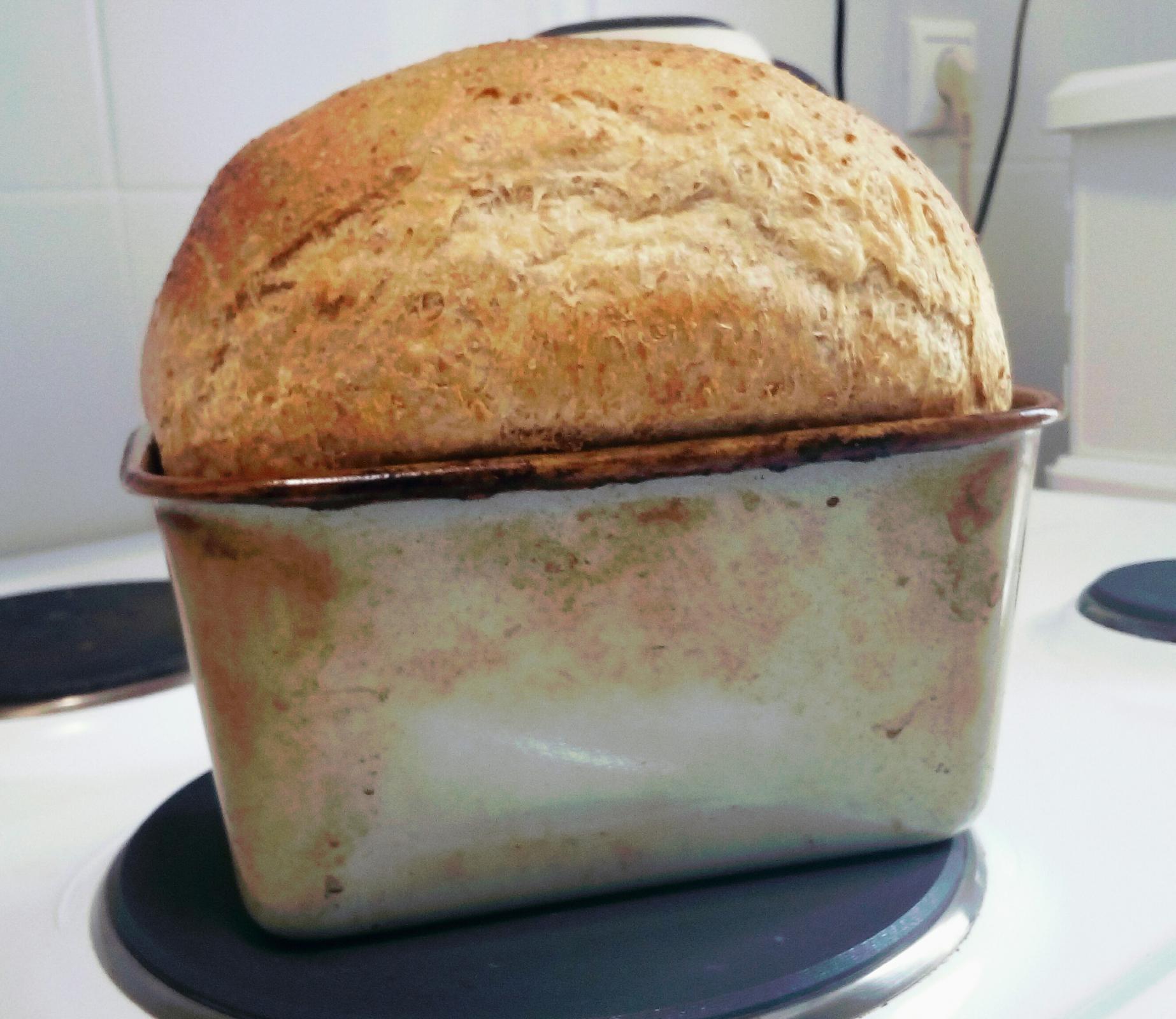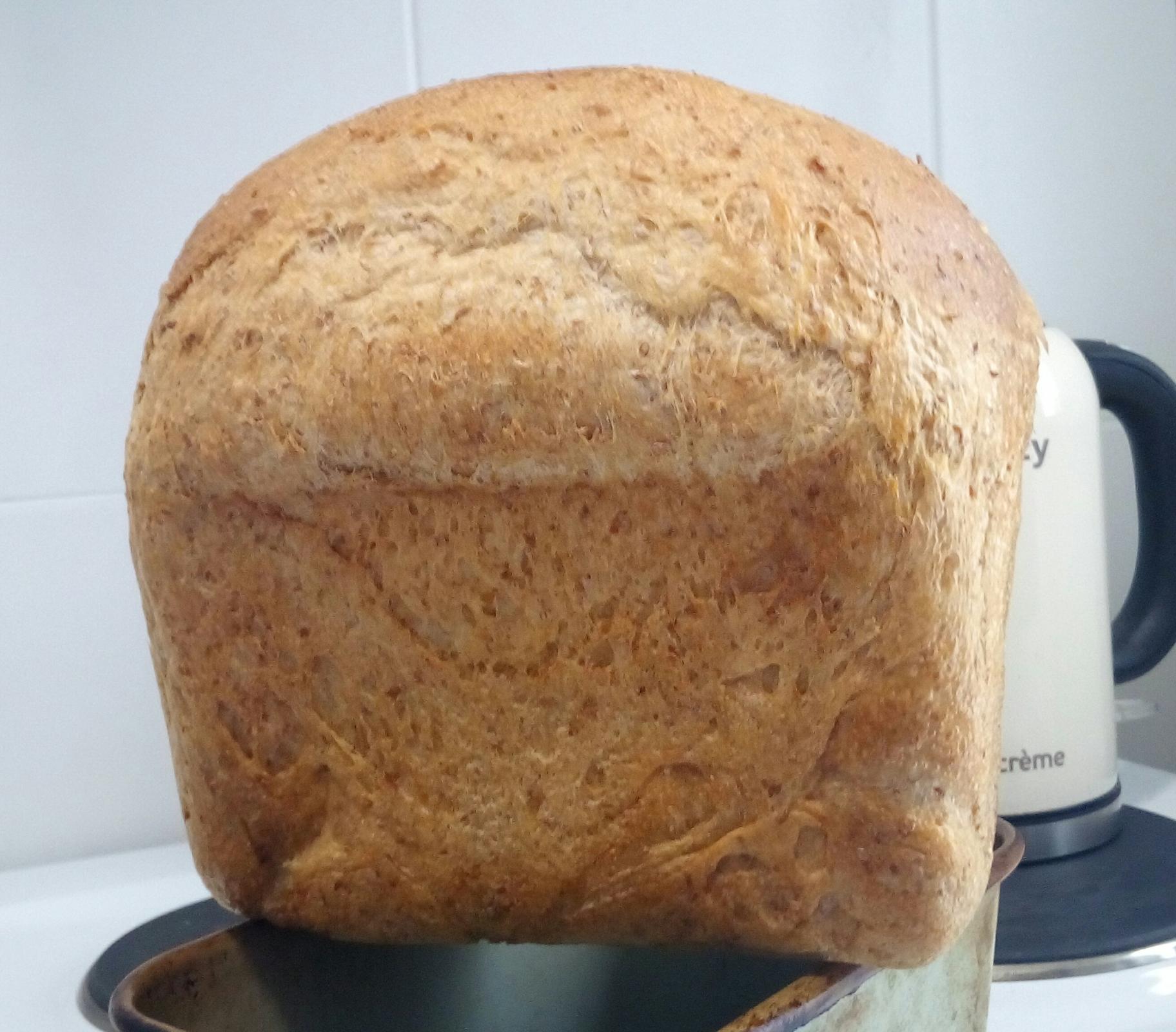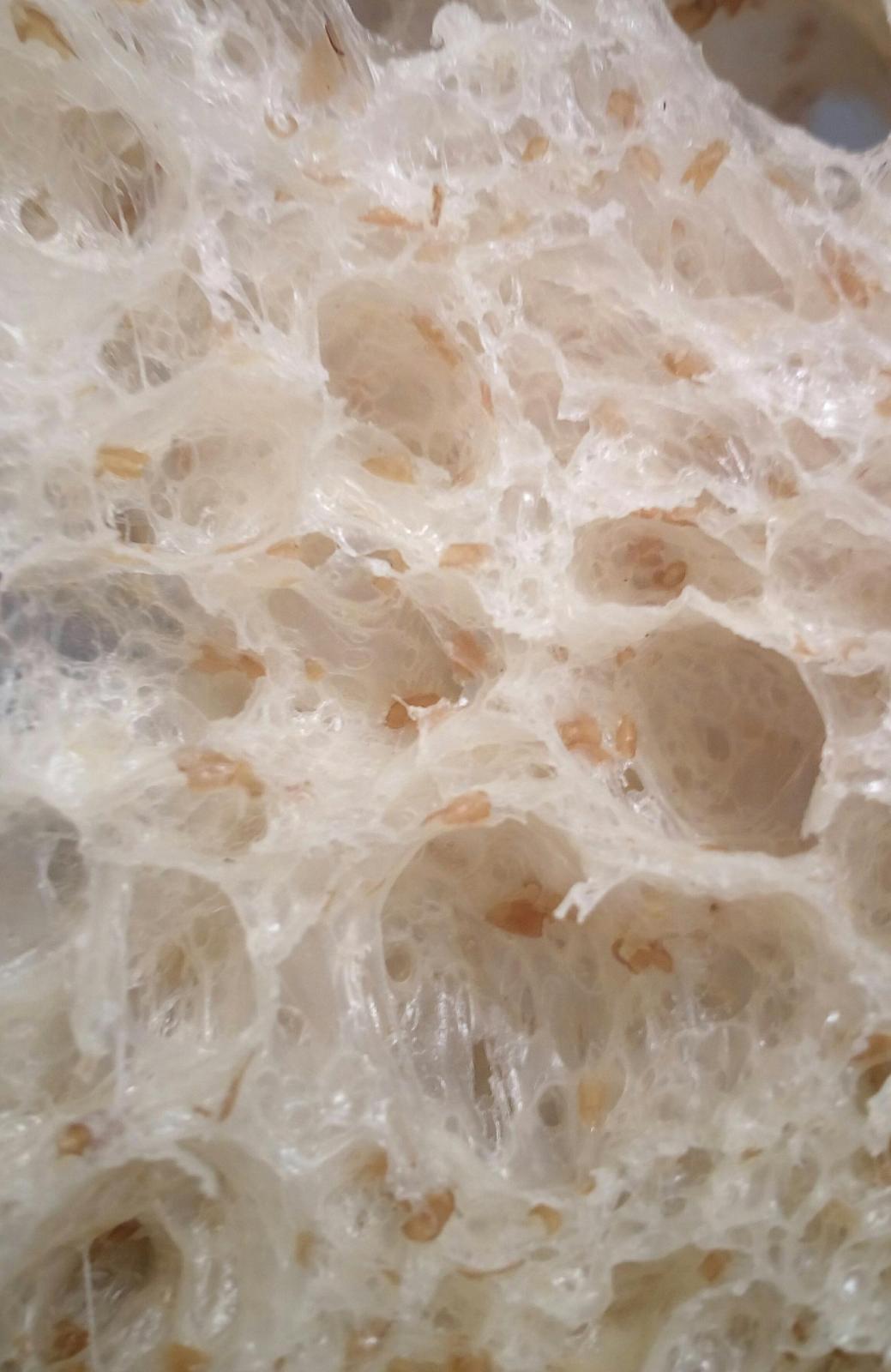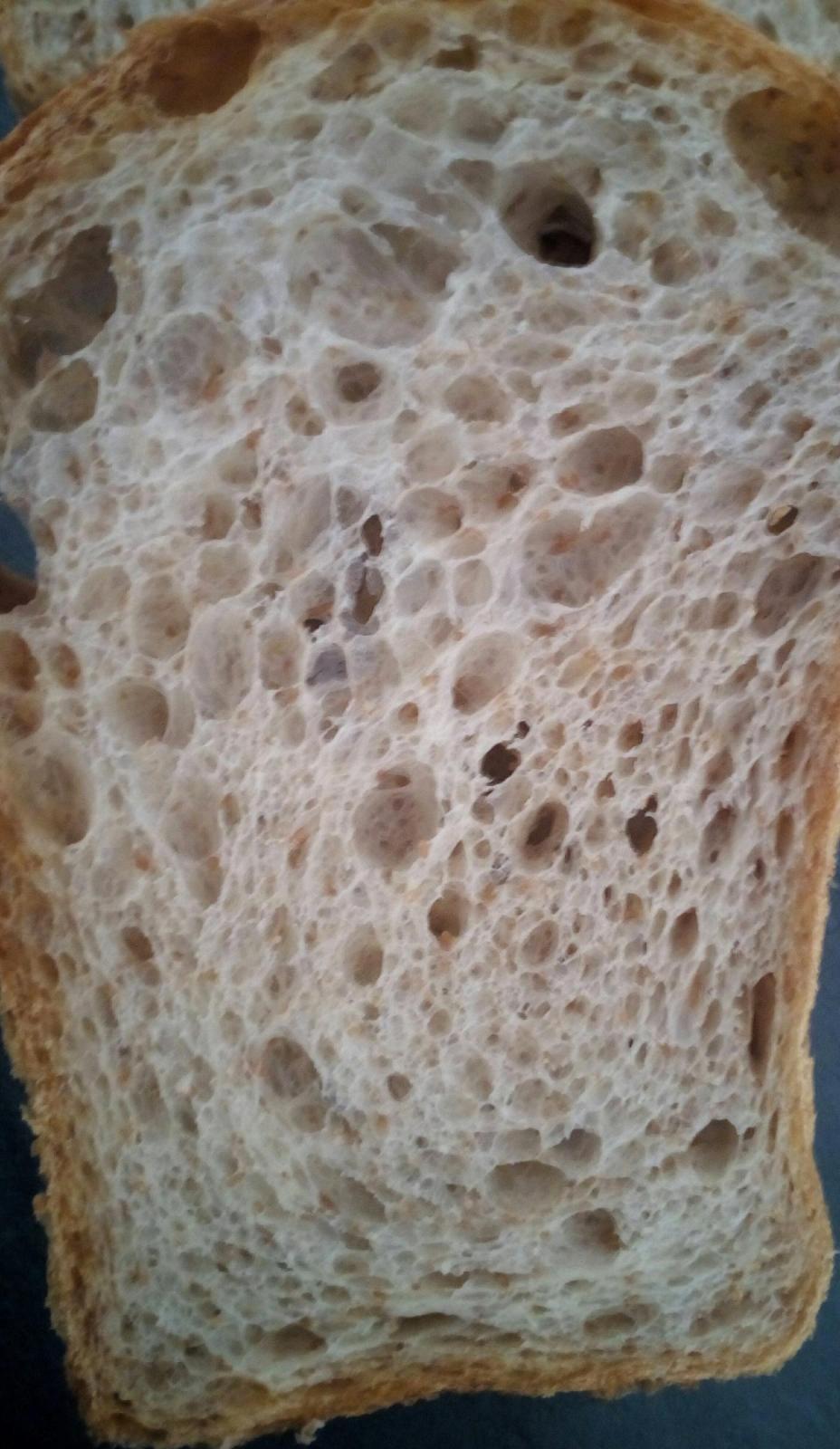This is how I make my sourwort-bread.
The 15g of wheat bran I add, makes the flour-bran mixture equivalent to ~50% store-bought whole wheat flour.
(you can use straight store-bought whole wheat flour for all that matters, it will be just as fine).
Formula
200g flour (wheat bread flour 13-14% protein)
90g water (tap)
60g sourwort (as desribed in my previous post)
1.6g instant dry yeast
4g salt
+
15g wheat bran (soaked in the fridge for over 24 hours refreshing the water and strained just before use)
Timeline
00:00 Mix all ingredients together using stand mixer for 4-6 min (start of bulk - Brod&Taylor setting 28C|82F)
00:30 Laminate
01:00 Roll&Fold (no excessive streching required) in basin where dough rests
01:30 Shape and place in 1Lt Pan (start of proof - Brod&Taylor setting 35C|95F no humidity disk as in bulk)
02:30 Bake (3 min at 250C|482F for oven-spring, then covered at 200C|392F for 57 min)




My small flat is now bursting with pleasant bakery aromas all over the place and each slice is hard to hold straight with one hand cause the crumb is extremely fluffy and tasty. I doubt if my little loaf will exist after a couple of hours.....!!!!
I've got to try this. Tell us about the taste. Is it sour? I'm always looking for sour.
Thank you 'GaryBishop'
I wouldn't say it is sour, as we are used with sourdough. It has its own peculiar taste I could not easily describe. Something like sweet&sour rather. Very pleasant to me anyway. You have to try it yourself maybe letting the mash brew longer (like 48 hours instead of 36) if you are a 'sour' fan as you mention.
The other thing I am planning to experiment with is to use spelt malt (or other) instead of rye. This will result in a different taste profile, I suspect. Good luck with all.
Wow! That is absolutely stunning!
Gorgeous tall loaf, perfect for sandwiches.
Benny
I can't tell from the photos. 200g seems about right for my tiny 10x10x10cm pan.
I want to try this beautiful loaf.
Oh, I just saw that you told me it is a 1 liter pan. Great. My pan is 1L.
Just came out of the oven. Not crazy tall like yours but a reasonable 4.5" tall.
The starter came out of the fridge still cloudy and brown as I think it should be. It does not smell like green apples to me or my wife. It smells sour and still slightly putrid. Maybe I didn't ferment it long enough?
The dough was very slack and sticky. I added 25g additional flour it became a little more cohesive. It felt over proofed from the start. Maybe the amount of incoming acid?
I scraped it out onto the counter and let it proof for about 1 hour with a few stretch and folds and then into the pan. The pan went into the oven at an average of 90F.
I baked when it got to the top of the pan.
The texture and chew are about as expected for an unenriched bread. The flavor is good. Sour but not excessively. It tastes different from my sourdough which is sour on the back of the chew and more yogurty.
I'm going to try making a new batch of starter with more carefully controlled temperature to see if I can get that green apple smell.
This is good fun. Thanks for the idea and pointers.
M first loaf had a hint of putrid smell resulting from my poor job of fermenting the first batch of FLAS. So I made a new batch of starter being careful to control the temperature at 43.5C and feeding every day with 1 tsp. of sugar as instructed in the German article. Much better smell after 3 days of fermentation.
I baked today and this loaf is great. Really light, crazy tall and good tasting.
In the picture below I compare two loaves. On the right is the loaf I baked on Tuesday with a total of 250g of flour and 100g of SD starter discard (for flavor) and CY to raise it. On the left is today's loaf with 200g of flour and 30% FLAS (no SD starter at all) and CY. They are otherwise identical. Note they are both 6 inches tall! (The loaf on the right is only the heel of the original loaf which is now mostly gone).
The FLAS loaf tastes great. I wouldn't mistake it for SD but it is really good. My wife likes it better.
It is really light. Like Hokkaido milk bread light!
May the Force 'Flas' be with you........!
No wonder it's light!
Congrats! 👏👏👏
I'm curious if it tastes sour with that much FLAS in the formula.
Yippee
I am stunned at the height. I'd prefer 5 inches tall which implies I'd use 166g of flour which seems really low for a 1L pan.
It didn't taste sour to me on first taste today just after it cooled. Tomorrow morning will be the real test.
I used 30% FLAS following her example.
Because I don't make sour bread myself, I couldn't answer Alco's question about souring a loaf. So I am poking around FLAS for possible answers 😃
Thx
Yippee
Nice work Gary, looks and sounds great. I made two doughs last week with my mash solution, one for a baguette and one for a pizza but I screwed up the baguette (overcooked) but the pizza was great. I am sold with this approach so I can confidently toss my SD starter now.
I am brewing my second mash right now and I hope it will be better with a correct temp dialed in. The smell was awful though for the first 24 hours (I did not open it for my first brew, but I did with this second one) so I hope it will smell (sweet and sour grain aroma) like the first did at the 48 hours mark.
Mine still smelled terrible at 48 hours but was fine at 72. So, if it still stinks, keep fermenting. It will get there.
Are you adding sugar? I added 1tsp each day.
Yeah I will open it again tonight at the 48 hours mark to check it out. No, I do not plan on feeding it anything at this point, I might do that down the road if it became a better approach.
Mariana said that the mash can become stagnant if it runs out of sugar.
Yeah, I saw that comment, but it did not smell bad for my first brew in 48 hours and the originator did not add sugar in his/her brew. Again, we are at the beginning of doing this so anything can change down the road.
I have just checked my second mash at 48-hour mark; the bad smell was still there but not as strong as yesterday's. The temp was around 108-degree F which should be right on the money. It looks like this will be a 3-day affair at this temp going forward. For my third mash next week, I will try to add some existing mash solution into the initial mix hoping to reduce the awful smell. The bad smell must be caused by the gas producing bacteria similar to the phenomena with the first couple of days of creating a new SD starter. I will need to get a pH meter to start measuring the solution to gauge its readiness.
I'm very interested in propagation. Mariana says
If I interpret her correctly, I think she means a second batch should go much quicker.
I got enough from the first batch to make about 8 small loaves which could carry me for almost 3 weeks. If I could then make a new batch in a day this would be a HUGE win.
I too would like to get a pH meter but I hate the idea of keeping it in a soaking solution, calibrating, etc. (Though I've never done it).
For measuring pH, you could always use narrow-range pH paper. I used pH meters often in a chemistry lab career and they can be a pain to maintain. The upfront cost of the meter and the ongoing maintenance supplies have put me off using one. In the lab, I usually preferred to use pH paper for its ease of use unless a more accurate measurement was necessary.
Thanks! This community is great because we have people with so many different experiences.
It seems to me (as a computer guy) that a smartphone camera combined with these strips and some math could make pretty accurate measurements. Colorimetry on the cheap?
https://www.sigmaaldrich.com/US/en/products/analytical-chemistry/photometry-and-rapid-chemical-testing/ph-test-strips-paper-readers-and-accesso…
I don't think you'd actually need an "app", a web page with a bit of code could do the job.
alcophile, I use pH paper as well. The very same you linked on Amazon. It is sufficient for the purposes of baking at home or in a bakery. Especially, considering the fact that it is not pH per se but TTA, total titratable acidity, that matters in starters and bread. And TTA is very easy to determine at home using cheap TTA kits sold for wine makers at home brewing stores and on amazon.
pH is mostly important as means of communicating to others how acidic our starter or bread crumb is, because tastes differ and what feels acidic to one person might taste quite bland to another. To each value of pH in starters or bread crumb corresponds a huge range of TTA values, so pH is not a measurement of choice to determine the starter or bread dough readiness for baking.
Gary, I have the Hanna bread and dough pH meter and have used it now for some time. It is actually quite simple to use and maintain. I gently wipe it clean after use and place the tip in the storage solution in the protective rubber cap that the probe tip comes with. Some storage solution is included with the pH meter along with calibration solutions of 4 and 7 pH. I purchased more storage solution and calibration solutions from Amazon.ca which wasn’t a huge cost. I have found that the unit doesn’t require calibration very often as it really does keep the calibration for weeks. It isn’t much work to use and I’ve found it really useful.
Benny
Gary, if you are going to store your soured wort for 3 weeks in the fridge for the purposes of baking, make sure to add some sugar or malt extract to it, even a slice of wonderbread would do, a piece of bread floating in your sourwort, otherwise it will become a graveyard of bacteria and will negatively affect your breads.
In the fridge, bacteria won't propagate, i.e. they would not multiply at such low temperatures (and that is the purpose of the fridge! to prevent bacterial spoilage), but they are alive, they continue to breathe, to eat, to produce acids, so there must be some sugar in the brew for them to keep going and not to die from starvation.
You don't really need a pH-meter for anything in homebaking. I only asked about your pH values because individual tastes (tastebuds on tongues that evaluate acidity) differ in numbers and efficiency, depending on age and genetics, and I wanted more or less objectively know how sour it was. I use pH paper, the one linked by alcophile. One small roll lasts for years if not for decades! : )))
ADDING SUGAR
Sure, Gary, before placing it in the fridge, add some sugar and at the end of each week add another spoon of sugar to it if it will continue to sit there. I usually add 1 tbsp (3 tsp) of liquid malt extract (it's a thick syrup) for each one month of storage (1Qt volume of flourless starter).
Crushed malt is not a good source of sugar that is why it is never used in beermaking directly, it is only used to prepare a wort from it, and inside cold refrigerator, inside sour FLAS the action of the enzymes that break starch into sugars is slowed down significantly, so you won't generate new sugars from it.
You can prepare a true wort from a portion of crushed malt. Wort is sweet and nutritious, yes. You can add that to your refrigerated FLAS. I gave a recipe somewhere above in the comments, where we discussed whether FLAS is a soured WORT or something else.
HOW TO MAKE BREAD MORE SOUR TO TASTE
(1) making starter more sour
The next batch at 42C - a batch started from scratch? Sure, you can hold it longer, for several days longer even. For as long as you will give it sugar, and for as long as its pH is above 4.0 bacteria will continue to multiply.
Should pH drop below 4.0 bacteria will stop multiplying and will simply live there. And for as long as they are alive and there is food for them (sugar, minerals, amino acids from whatever is in the solution) they will continue to 'work' to produce acids. Eventually it will become so sour that they will fall asleep, the solution will conserve/preserve itself at the maximum level of acidity, for at least 24 hours, the souring will slow down considerably, and after that they will begin to die out.
I have no experience with FLAS, but from my experience with CLAS I know that once you add too much acid with it, the bread doesn't just taste more acidic, it begins to taste weird. There is something going on in there, you add something with it that adversely affects bread quality. In essence, CLAS and very sour FLAS can be only used as bread improvers, i.e. to improve quality of yeasted and sourdough breads and to shorten the breadmaking time, in relatively small amounts
(2) preparing a preferment
The easier way to produce tang in your bread is to let FLAS work as a starter in your bread, i.e. let its bacteria produce acid inside bread dough. If you read the original Berlin wheat beer article where this rye malt starter is described, it is fermented only until it smells nice and is sour to taste. THEN it is used to sour beer wort to the desired degree of acidity, for several hours. I.e. the starter is made to work in beer, in the final product, to actively produce acids in order to give it the sourness that the beermeister desires.
For that you prepare a small sponge using FLAS as a liquid for it and a portion of flour from the recipe and keep it until it is sour enough to your taste, then add the remaining water, flour and salt as in the recipe and complete the steps of breadmaking. You can prepare that sponge beforehand and store it refrigerated for up to 24 hrs as well.
The FLAS-based sponge can be liquid, medium thick (100% hydration) or stiff, i.e. you can use a little or a lot of bread flour in it, it won't rise and it won't foam, because there is no yeast, but it will become more and more acidic and fragrant, just as any other sourdough levain, to taste as it sits at 28-32C for 2-4 hours.
This is how a FLAS -based preferment looks. It just sits there, no matter how many hours you give it, no matter how many times you refresh it, it smells delicious and it is sour, but it is not rising, not even one millimeter.
If you make it into a ball, you can see bubbles on the surface, it is air trapped in it due to kneading. There is no gas due to fermentation.
If it's too unusual for you to see a sponge or levain that doesn't rise as it sours, you can add a tiny pinch of yeast to it, a portion of yeast from the recipe, as well.
Hi,
I think my (first try) flas is ready tomorrow night. I would like to give the above recipe a try.
1) bulk 1.5 hr at 28C
2) shape then 1 hr at 35C
3)
In the formula above:
02:30 Bake (3 min at 250C|482F for oven-spring, then covered at 200C|392F for 57 min)
Does this mean no steam on the first 3 min and steam(covered) on the last 57 min? Do you spray the top of your loaf?
Thanks!
(I am going to use 50-50, fresh milled ww and KA BF)
No steam nor spray was used in this bake. Good luck.